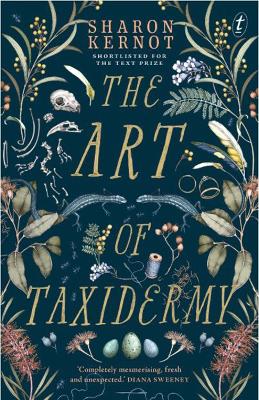The Art of Taxidermy is a slow burn, and I must admit, it wasn’t at all what I was expecting. It’s described as a novel, but it’s more than that. Essentially, it’s a piece of narrative poetry, and as such, is a short read. But Kernot really does a lot in minimal space. Her prose is deliberate and tightly woven. Because of the style and structure, not a word is out of place. There wasn’t a deep plot, or any unexpected twists and turns, but what it did show was a very personal look at grief and the beauty that can be found in death.
Australian flora and fauna are an integral part of The Art of Taxidermy, and as such, I’m not sure how much a non-Australian would get from it. This novel resonated with me so deeply because I felt a familiarity with its people and setting. Lottie’s family are German, and the prose is speckled with German words which are not always translated. Coming from a bi-lingual Australian/German family, once again, this was something that really resonated with me, but made me question just how much a reader not immersed in that culture would really understand in the nuances.
The corellas were grazingThere are some stunningly visceral descriptions of death, dying, and decay. While these may not be for everyone, I found them oddly beautiful. There is beauty in the fragility of life, and artistry in capturing those moments, and it was refreshing to see those things represented in a way that was more than merely violent and gruesome. It was a hopeful, loving novel, but still punctuated by an undercurrent of grief and loneliness. It was like the human condition was distilled into a few pages of prose, and I thought it was done masterfully.
with a scatter of galahs.
We sat on a fallen log
and watched them squabble and tussle,
beat their wings and waddle
like hook-nosed old men
with their arms tucked
behind their backs.
There isn’t a great deal of world-building, nor particularly in-depth characterisation in The Art of Taxidermy, but that didn’t matter. It wasn’t that kind of book. Reading it is more about the experience of it, rather than the enjoyment – and for that, I was glad of its relatively short length. Had it been any longer I think it could have become boring, but any shorter and it would have felt lacking. It was a pretty much perfect showcase of unique style and subtle story without overstaying its welcome.
I don’t think The Art of Taxidermy will be everyone’s cup of tea. I think it will appeal to a particular audience. So, if you’re like me and you’re an Australian/German with nostalgia for your home who is bi-lingual and has a love for Natural History collections, then this book was written for you. Alternatively, if you like unique structure and beautiful prose that probes the subtleties of the human condition, then this book might also be for you. There’s no doubt about it, The Art of Taxidermy is an ‘artsy’ book that needs to be experienced rather than simply read. If that’s the kind of book you like, then this will be right up your street.
